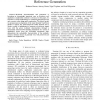Free Online Productivity Tools
i2Speak
i2Symbol
i2OCR
iTex2Img
iWeb2Print
iWeb2Shot
i2Type
iPdf2Split
iPdf2Merge
i2Bopomofo
i2Arabic
i2Style
i2Image
i2PDF
iLatex2Rtf
Sci2ools
IMECS
2007
2007
A Hybrid Markov Model for Accurate Memory Reference Generation
—Workload characterisation and generation is becoming an increasingly important area as hardware and application complexities continue to advance. In this paper, we introduce a concise methodology for workload generation for fast and accurate cache design space exploration. The hybrid model we propose uses an adaptation of the Least Recently Used Stack Model to capture key spatio-temporal locality features and a Markov model is implemented to generate an arbitrary length trace with the given workload characteristics through a dynamically ordered FIFO scheduler. Simulation of a variety of application traces from the SPEC2000 benchmark suite demonstrate the cacheability characteristics of the synthetic memory reference stream is generally very well preserved and similar to its original form.
Arbitrary Length Trace | IMECS 2007 | Key Spatio-temporal Locality | Theoretical Computer Science | Workload Generation |
| Added | 29 Oct 2010 |
| Updated | 29 Oct 2010 |
| Type | Conference |
| Year | 2007 |
| Where | IMECS |
| Authors | Rahman Hassan, Antony Harris |
Comments (0)

